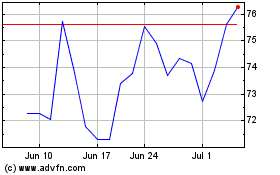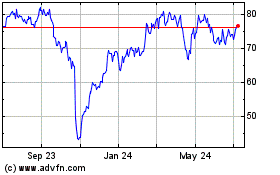Performance in the Consumer Credit Market Holds Steady as Number of Borrowers in Financial Hardship Status Stabilizes
July 23 2020 - 8:00AM

A new TransUnion (NYSE: TRU) consumer credit snapshot found the
percentage of accounts in “financial hardship” started to level off
for credit products such as auto loans, credit cards, mortgages and
personal loans during the month of June 2020. Some of this leveling
off was due, in part, to accounts coming out of financial hardship
status in June.
Accounts in financial hardship – defined by factors such as a
deferred payment, forbearance program, frozen account or frozen
past due payment – have largely kept delinquency numbers in check
as consumers continue to navigate the ongoing impacts of COVID-19.
TransUnion’s financial hardship data includes all accommodations on
file at month’s end, and includes any accounts that were in
accommodation prior to the COVID-19 pandemic.
Accommodation programs have provided consumers with much needed
payment flexibility as external triggers such as rising
unemployment and a decrease in government relief funds have started
to shape the future outlook of the consumer wallet.
|
June Industry Snapshot of Financial Hardship Status by
Credit Product |
|
Timeframe |
Auto |
Credit Card |
Mortgage |
Personal Loans |
|
June 2020 |
7.21% |
3.57% |
6.79% |
7.03% |
|
May 2020 |
7.04% |
3.73% |
7.48% |
6.15% |
|
April 2020 |
3.54% |
3.22% |
5.00% |
3.57% |
|
March 2020 |
0.64% |
0.01% |
0.48% |
1.56% |
|
June 2019 |
0.40% |
0.02% |
0.47% |
0.26% |
“In the early months of the pandemic, unemployment benefits and
relief from the CARES Act gave consumers a bit of a cushion,
leaving the consumer fairly well-positioned from a cash flow
perspective,” said Matt Komos, vice president of research and
consulting at TransUnion. “Lenders have been working with consumers
during this time of uncertainty by extending financial hardship
offerings that help them understand and manage their financial
situation. These accommodations have been working as intended and
have helped thwart a material breakdown in delinquency performance
in the near-term.”
Since the pandemic began in March 2020, delinquency performance
has held steady, with credit products across auto, credit card,
mortgage and personal loans all showing a recent month-over-month
improvement in performance from May to June 2020.
Credit cards saw the greatest decline in delinquency over this
period with borrowers 90+ days past due (DPD) decreasing from 1.76%
to 1.48% month-over-month. This decrease also held true for
accounts in 30+ DPD delinquency status – an early indication that
may signal consumer distress – by decreasing from 3.06% to 2.66%
from May to June (compared to 3.49% at 30+ DPD in June 2019).
Consumer balances for credit card also showed a 7.41%
year-over-year decline from June 2019 to June 2020 as well as a
monthly balance decrease of $43 since May. These decreases may
signify that consumers are continuing to manage debt prudently and
are paying down their existing card balances. At the same time,
overall consumer credit lines have declined from $24,641 in June
2019 to $23,724 in June 2020, which is also down from $23,800 in
May 2020.
“These are signs of a credit market that continues to function
despite the spike in consumer unemployment,” said Paul Siegfried,
senior vice president and credit card business leader at
TransUnion. “When there is uncertainty in the market, consumer
credit performance is highly scrutinized and new accounts generally
will not receive the same type of credit limit as they might have
prior to a crisis. However, the longer individuals who are not in
an accommodation program perform well, the more likely additional
credit will be extended.”
|
June Industry Snapshot of Consumer-Level Delinquency
Performance by Credit Product |
|
Timeframe |
Auto |
Credit Card |
Mortgage |
Personal Loans |
|
June 2020 |
1.50% |
1.48%* |
1.07% |
3.11% |
|
May 2020 |
1.55% |
1.76%* |
1.14% |
3.14% |
|
April 2020 |
1.33% |
1.87%* |
1.27% |
3.27% |
|
March 2020 |
1.37% |
1.96%* |
1.40% |
3.40% |
|
June 2019 |
1.23% |
1.71%* |
1.36% |
3.10% |
*Credit card delinquency rate reported as 90+ DPD per industry
standard; all other products reported as 60+ DPD
Over the course of the pandemic a substantial segment of
consumers have continued to make payments, but are also proactively
engaging with their lenders to discuss payment options.
TransUnion’s ongoing Financial Hardship Survey indicated that of
consumers with a current financial accommodation on a loan, 32% are
in favor of repayment plans that will allow for paying down debt
gradually while continuing regular payments. A smaller percentage
(18%) preferred paying off all postponed payments with a lump sum
and 21% indicated they would like financial accommodations to be
extended further.
“By many accounts, we are still in the early phase of the
pandemic, and there is some uncertainty still around the nature of
the economic recovery we may experience. It will likely be months
before the financial impacts of COVID-19 begin to materialize from
a credit performance standpoint, and some of this will be dependent
on any additional government actions. During this period of time,
lenders will need deeper consumer insights to better calibrate risk
across their portfolios and make more informed decisions,”
concluded Komos.
TransUnion’s June Monthly Industry Snapshot Report features
insights on consumer credit trends around personal loans, auto
loans, credit cards and mortgage loans. Additional resources for
consumers looking to protect their credit during the COVID-19
pandemic can be found at transunion.com/covid-19.
About TransUnion (NYSE: TRU)TransUnion is a
global information and insights company that makes trust possible
in the modern economy. We do this by providing a comprehensive
picture of each person so they can be reliably and safely
represented in the marketplace. As a result, businesses and
consumers can transact with confidence and achieve great things. We
call this Information for Good.®
A leading presence in more than 30 countries across five
continents, TransUnion provides solutions that help create economic
opportunity, great experiences and personal empowerment for
hundreds of millions of people.
http://www.transunion.com/business
|
Contact |
Dave
Blumberg |
| |
TransUnion |
| |
|
| E-mail |
dblumberg@transunion.com |
| |
|
| Telephone |
312-972-6646 |
TransUnion (NYSE:TRU)
Historical Stock Chart
From Mar 2024 to Apr 2024

TransUnion (NYSE:TRU)
Historical Stock Chart
From Apr 2023 to Apr 2024
